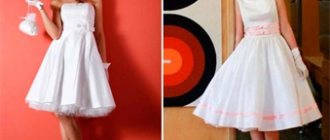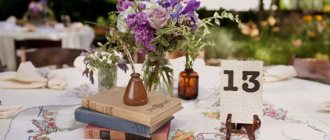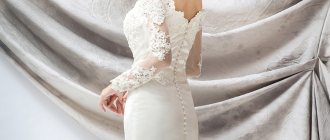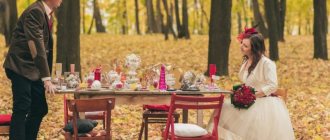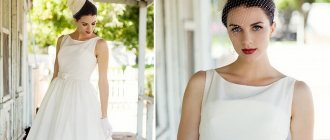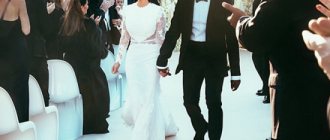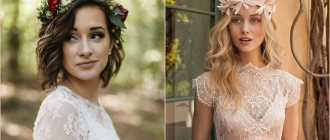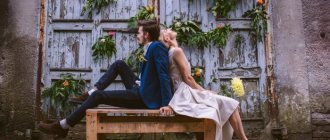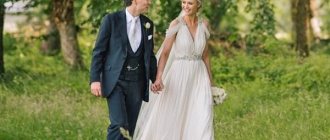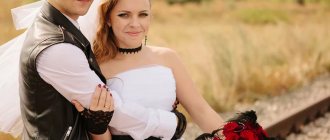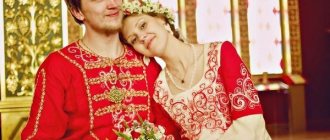Vintage style has always been considered one of the most advantageous. Fashion is constantly changing, but nevertheless it often returns to those old, but still relevant trends.
If you wear your grandma's wedding dress and add modern details, the bride won't look ridiculous. This is a retro look that is so popular and common today.
Every girl, at least for a moment, wants to feel like a film star of the 70s, a star of the 80s and a heroine of the 90s. All this can be done at a wedding by choosing the right dress and appropriate accessories.
Retro wedding: how fashion for wedding dresses changed in the 20th century
Throwing a wedding in vintage style? Easily! The main thing is to choose a dress to your liking. We tell you what wedding dresses were worn by fashionistas of the past - and which of these trends will return to us in 2019.
Share:
Hairstyles and make-up
The best look for the bride is loose strands wrapped in large curlers or a Greek hairstyle. A wreath with flowers must be woven into the hair, or buds are inserted separately if we are talking about braids. A wedding hairstyle should be slightly careless, disheveled, reminiscent of freedom, grace, and femininity. Makeup should not be flashy, use pastel colors. Highlight your most expressive facial features and keep your peace and smile for the rest of your life. The naturalness of the image is the main rule of make-up in the hippie style.
40s
Then: wedding fashion has always gone hand in hand with everyday fashion, reflecting and in its own way complementing the main fashion trends of the time. For example, in the 40s, a strict silhouette with an emphasis on the shoulders, suspiciously reminiscent of a military uniform, came into fashion.
Wedding dresses of the 40s were also distinguished by their “shoulderedness” - puffed sleeves helped a lot with this. The neckline area was often decorated with a geometric shirt collar. And so that the bride would not forget that she was still a girl, the outfit was decorated with lace and a long, voluminous (by the standards of that time of scarcity) skirt.
Now: The '40s are making a comeback in bridal fashion today in the form of tailored silhouettes with an emphasis on the shoulders. The accent can be vintage voluminous sleeves, as in the collection of wedding fashion guru Vera Wang, as well as all kinds of capes and trains.
Vintage
Vintage is a fashion trend whose goal is to revive old trends and create stylizations of once popular trends.
Greek
Mediterranean vintage is characterized by lightness and airiness. Greek style dresses are simple and elegant. They are almost always long, made from airy fabrics and have an elegant style, decorated with pleated inserts and belts, and can have an asymmetrical cut.
Victorian
Interesting! Queen Victoria, whose name was given to an entire era, became a trendsetter in the field of snow-white wedding dresses.
Characteristic features of Victorian vintage:
- grace;
- wealth;
- luxury;
- romance.
Each subsequent era gave Victorian retro dresses its own characteristics: the 20s - low waist, the 40s - puffed sleeves, hippies - embroidery and folklore motifs. Thus, traditional Victorian dresses with a tight-fitting bodice and a fluffy skirt made of organza, cashmere, silk, and linen were transformed into fitted asymmetrical A-dresses with a long train. Only the color remained unchanged - white or ivory.
50s
THEN: The 1950s were the antithesis of the heavy 40s. Voluminous shoulders and other nods to military uniforms are a thing of the past. In their place came a delicate feminine silhouette with a thin waist and a fluffy skirt reminiscent of a half-blooming flower. Fashionistas were much more willing to expose their décolleté and often their shoulders.
Brides of the 50s also liked this airy “floral” look. Wedding dresses of this period were not much different from evening or cocktail dresses - color does not count. The wedding outfit was complemented by a set of high snow-white gloves and elegant pointed pumps.
Are you getting ready for your wedding? We know where the widest selection of engagement rings is >>>>>
and jewelry >>>>> for a fabulously beautiful bride
Now: modern wedding fashion most actively borrows lush floral skirts from the 50s, making them even more lush and airy - a real princess dress, as in the current Hayley Paige collection.
60s
Then: the free 1960s were remembered by subsequent generations as an era of innovation and experimentation, including in the world of fashion. It was during these years that a real fashion revolution took place. The fitted silhouette gave way to a loose cut, the elegant knee-length skirt was replaced by a daring mini, minimalism and unisex styles made themselves known.
Radical '60s brides adopted tiny straight sheaths - often without sleeves or even a hint of traditional wedding decor. However, a more conservative version of the dress was also a great success among fashionistas of the 60s: a mid-knee skirt, a fitted silhouette, a geometric cut and, of course, a minimum of decor.
Now: the laconicism of the 60s definitely appealed to modern fashionistas. Top wedding designers like Angel Sanchez always include in their collections simple dresses with a geometric cut that emphasizes the figure.
70s
Then: the environmentally friendly seventies forced fashionistas all over the world to leave behind the synthetics, plastic and space motifs of the previous decade and come down to earth. The strict geometry of forms was replaced by flying silhouettes, the futuristic color scheme was replaced by calmer natural colors.
Folklore motifs have also penetrated into wedding fashion. Long dresses of a simple cut a la “peasant young lady” have become especially popular. Frills, embroidery and lace added luxury to such wedding dresses of the 70s.
Now: romantic dresses in the style of the 70s - loose fit, embroidery with floral patterns, lace - are very popular among modern fashionistas. Plus, the disco style with its more daring attributes imposes its own sign of the times.
80s
Then: Shoulders came back into fashion in the 1980s. True, the rest of the fashion of this era was the complete opposite of the modest trends of the 40s. In addition to shoulder pads, stylish girls dressed in sequins, lurex, large frills, one-shoulder tops, mixed sporty style with casual ones, combed their bouffants and put on massive earrings.
Wedding dresses of the 80s also tended towards excess: luxurious fabrics, lace, sequins and a pronounced emphasis on the neckline, reinforced by shoulder pads and batwing sleeves. It was in the 80s of the 20th century that the well-known cake dresses appeared - lush multi-layered dresses in which the bride could easily get lost.
Who suits 50s style fashion?
The skirt in this outfit is flared and slightly fluffy. Therefore, this style can hide figure flaws in many girls.
- For very thin young ladies - due to the voluminous bottom, it will be possible to make the hips wider. At the same time, a thin waist, slender arms and décolleté area will be preserved.
- For girls with wide hips – the hourglass figure type means a clear and thin waistline, with wide hips and large breasts. By opening the décolleté area, you can highlight beautiful shapes. And by hiding your hips, you will be able to achieve a slimmer figure in the end.
- For women with full calves, a flared skirt allows you to vary the length . If the girl has slender legs, then you can go with a shorter version, slightly covering her knees. And if you have problems with excess weight, you should add length.
A vintage wedding dress is suitable for romantic ladies who want to create a flirty look. A woman should feel free in the outfit she has chosen.
Dresses from the 50s are not very revealing, but they look quite cute and gentle. If the bride wants to create a sexy and provocative image, then the fashion of the 50s will definitely not suit her.
Cut and design options
Existing versions of retro wedding dresses are the most successful stylizations of models of the last century, adapted to modern trends.
Sleeveless with bare back
This retro dress design is from the 20s and Gatsby style. The loose, sleeveless silhouette features a completely flat front that contrasts favorably with the deep cutout at the back.
Silk, chiffon, lace, and velvet are used for tailoring. For decoration - precious and artificial stones, pearls, beads, fringe.
Train and cutout at back
Wedding dresses with long trains and low backs came in a retro style from the 30s. They were made of satin and silk.
A similar cut is also typical for vintage outfits - Greek and Victorian. In the first case, the naked back is decorated with draperies that smoothly turn into a train. In the second, the train “grows” out of the skirt, as it forms a single fabric with it.
Full skirt and tight top
The A-silhouette is typical for dresses of the 50s and 60s. It is suitable for brides who want to emphasize a graceful waist and hide imperfections in the hips (excessively wide or, on the contrary, too narrow).
Retro wedding dresses of this type are made both from simple fabrics (the designers do not skimp on decor - lace, pearls, rhinestones) and from luxurious fabrics such as satin.
If you're looking for a classic, retro A-line dress for your wedding, opt for a long satin gown in a light shade with a full skirt for an elegant look.
Deep neckline and corset
A retro wedding dress with a deep neckline and a lace-up corset is a reference to the design of the Victorian era, which lost chastity and gained boldness and sex appeal.
Many brides choose this particular design for a wedding dress to emphasize the waist with a corset, open up the neckline and make the silhouette graceful with a long and full skirt.
What do 50s style dress styles look like today?
All girls in the world should know who created the stylish dress of the 50s and is at the origins of this fashion. Christian Dior is a name that is known throughout the world. He is considered the creator of fashionable dresses that are still worn today.
Wanting to recreate the look of the 50s, the bride, first of all, should know what basic requirements a wedding dress from this era meets:
- The length of the style is just below the knee.
- A bright accent at the waist (ribbon, corset, cinching element).
- Open hands.
- The top always fits tightly to the body, possibly showing an open neckline or back.
Dress styles vary depending on several indicators:
- Length – the classic option in this case is a length just below the knee . You can often find modern versions, the so-called new look, in which the length is a few centimeters above the knee. In this case, a more voluminous skirt is required. Designers are trying to be more original and suggest using flower shapes or flares of different lengths as options. These are completely acceptable styles of dresses from the 50s, modernized and translated into a new way.
- Sleeve - the summer version assumes a complete absence of sleeves, although a flashlight sleeve, 3/4, short or long, is also possible. It is traditionally believed that a dress of the 50s does not require sleeves at all. However, as an original decor, couturiers add puff sleeves or make an insulated version of the outfit with long sleeves.
- Neckline - round, heart-shaped, triangular, rectangular - this is only an incomplete list of possible types. If you have large breasts, you should give preference to the décolleté area. To create a more romantic and playful look, you can choose a sweetheart neckline on the back.
- Material – natural materials are always chosen as the main fabric. Is it linen or cotton. If you want to make the image more festive and solemn, you should choose satin or velvet. This style always looks more formal and elegant.
Models – with photos
There are a great variety of retro wedding dresses. They cover the period from the 20s to the 70s of the XX century.
"The Great Gatsby"
While on one continent the kings of smuggled alcohol made a fortune from Prohibition, and on another continent they were recovering from the shocks of the world war, women all over the world gained the opportunity to become more relaxed: not only in their behavior, but also in the choice of chic outfits that were so lacking in the difficult wartime.
In the 20s, the years of dazzling glamor and brilliant jazz, fashion designers abandoned full skirts and confining corsets. Elegant dresses of a loose rectangular cut with a bold neckline, usually on the back, have come into fashion.
Interesting! Modern fashion for dresses of the 20s returned after the release of the film “The Great Gatsby” with the inimitable Leonardo DiCaprio.
Dresses with a rectangular silhouette perfectly hid figure flaws, be it a not too thin waist or a protruding tummy. The aristocracy and sophistication of the image helped to emphasize the neutral shades of noble fabrics: silk, velvet, lace, chiffon. Fringes, precious stones, embroidery, furs or feathers were chosen to decorate dresses.
The following accessories were used:
- pearl beads;
- neckpiece;
- gloves;
- feather boa;
- fur coat;
- a small bucket bag embroidered with stones or beads.
The hairstyle should be complemented by:
- silk scarf;
- mesh veil;
- miniature hat;
- bandages and forehead coverings decorated with pearls, rhinestones, stones and beads, feathers.
Today, brides are offered retro dresses with a rectangular silhouette and low waist in ivory, beige or cream. There should be no emphasis on the waist, and if you don’t want to open your back, then the neckline area should be covered with lace or chiffon. It is better to avoid sleeves. Length - just below the knee.
Chicago
The fashion of the 1930s was influenced by the economic crisis and the Great Depression. There was a catastrophic shortage of money, people were fired from factories that were closing everywhere, and therefore most women could not afford chic outfits.
The glamor of the Jazz Age was replaced by understated elegance. The dresses were quite long: ankle-length, and sometimes longer. Very short skirts were not encouraged.
Long dresses with slouchy hips, the style of which later became known as “Chicago,” were very popular. They were made from dense fabrics: satin, silk, velvet or chiffon. Generous drapery or flounces became a characteristic feature. Small hats, fur coats and long gloves were chosen as accessories.
In the 30s, the color of the dress could be any, but for a modern wedding it is better to choose white, ivory, soft pink or cream. This outfit will give your image strict elegance and grace.
Military 40s
Wartime dictated the strictest economy of resources: the shortage of textiles, which was required for sewing uniforms, led to the fact that the skirts of women's dresses became shorter (to the knees) and narrower. The top of the dress, blouse or jacket seemed to be cut according to the patterns of a military tunic. It was in the 40s that wide square shoulders came into fashion.
To add elegance to the look, resourceful women used accessories - primarily a variety of hats.
Interesting! After the occupation of France, American designers and fashion designers became trendsetters.
Today, wedding dresses in the style of the 40s are a delicate texture of tulle and chiffon, bare shoulders or long sleeves.
Luxurious 50s
Yearning for color and bold decisions during the years of war restrictions, designers returned bright dresses with a deep neckline and a fluffy short skirt to the catwalks in the 50s. Often, very bold and sexy outfits were worn by busty women with wide hips, because the fashion for thin young ladies with languid eyes had passed.
Preference was given to the hourglass silhouette, which had great advantages:
- the skirt widened at the bottom created the effect of a wasp waist;
- a knee-length or floor-length bell skirt hid wide hips;
- the knee-length made it possible to demonstrate the beauty of the legs;
- The deep neckline emphasized her ample breasts.
Today, wedding dresses in the “new look” style are a multi-layered full skirt, a wasp waist, a corset or open shoulders, and a small hat (or its imitation). If in the 50s the accents of makeup were scarlet lips and black wide eyeliner, then today's brides should choose this option only if they are absolutely sure that it is suitable.
Hipsters
The sixties continued some of the trends of the previous decade and abandoned others. The skirts retained their layering, the belt still focused attention on the thin waist, but the neckline began to disappear (with the exception of the V-shaped neckline on the back).
The color scheme is absolutely free, but the brighter, the more fun it is to boogie-woogie. Geometric prints (especially chic - a skirt with large polka dots with a starched petticoat), bright jewelry, bow headbands on a fluffed up hairstyle, large eyelashes and a doll-like look - the image demanded extravagance, courage, and recklessness.
Today, brides can choose a white dress with a characteristic A-line silhouette and add retro notes to it with bright details : large beads, a high bouffant, a contrasting belt, a fluffy petticoat.
Hippie
Hippie style is a protest against the system, stereotypes and inequality. “Flowers of Life” advocated peace and love, chanting “Make love, not war!”, which literally means “Make love, not war!” The hippie worldview also influenced the formation of a style whose hallmarks were simple silhouettes, unpretentiousness, originality and ethnic motifs.
Hippie clothes are old jeans, without labels or brands, jackets and vests with embroidery or fringe made from natural fabrics.
Interesting! Hippie accessories - baubles, ribbons or thin braided hair cords.
It takes a lot of courage to wear a hippie dress to a wedding. The colors alone are worth it! They can be natural earth tones (brown, green, yellow) or acidic with various psychedelic patterns.
An important point for the hippie look is the hairstyle. For women, this is usually long, flowing hair, sometimes braided or tied into ponytails. Often hippies would braid a thin braid or several, leaving the rest of their hair loose and weaving threads, beads, beads or ribbons into the braids.
What to combine with 50s dresses
Hats
You can create a bright and interesting look by adding an accessory. At the same time, you should not overdo it, so as not to distract attention from the main detail - the dress .
Hats are the element that the bride's image is missing. Stylish hairstyles, smoothly combed hair - this is required in order to put on an original headdress. So-called bowler hats were at the peak of their popularity in the 1950s. Of course, they are suitable as an accessory only for the cold season.
Veils and flirty hats with feathers are suitable for summer and warm spring. A silk scarf is offered to completely original and stylish ladies. At the same time, the hair should be heavily backcombed and tucked under a scarf. The accessory is tied under the chin.
Voluminous hats will suit fluffy and wide skirts. They are decorated with flowers or ribbons. As a rule, the decorations on the hat are bright and juicy.
Shoes
The 50s were the time of pointed or slightly cropped shoes. At the same time, the shoes are delicate and laconic. It is not decorated with anything. The maximum that can be added is the brightness of the colors. For example, wear red shoes and highlight bright lips.
Colors and shades
Retro style is quite diverse, as we have already understood, therefore there are no color restrictions in it either. Naturally, as for a classic wedding, it is characterized by more pastel colors, such as:
- white;
- beige;
- Ivory;
- vanilla;
- cream.
But in some periods of time, brides simply did not want to follow established stereotypes and walked down the aisle in bright colored dresses. That is why today there is no specific color scheme for retro dresses, they can be:
- pink;
- black and white;
- blue;
- yellow;
- lilac;
- green.
How to choose a wedding dress in retro style - fashion for brides from the 50s to the 80s
Every bride wants to be the most beautiful at her own wedding, but this is rarely achieved by those who use classic methods of celebrating the holiday. After all, there is a high probability of meeting a girl in the same dress, especially if registration is carried out at the registry office, or if you are planning a walk around the city.
But if you wear a wedding dress in retro style, that is, from the past, then the image will be unusual. In addition, such an outfit will help create the right mood and will look stylish in the photo. And thanks to the unusual appearance of the newlywed, guests will remember the holiday for a long time.
Details
It is very important to observe full immersion at the chosen time. This also applies to such details as the photo zone, invitations, event program and staff clothing.
KNOWLEDGE BASE: Wedding colors 2022: photo selection of fashionable shades for the bride and groom
Photozone
The place for the photo shoot should stand out from the interior so that guests can immediately understand what’s what. You can safely stand out with the pomp and abundance of colors on the banner, specific details and accessories that will show that you belong to the general style of the wedding. It is also possible to use colored frames as a photo zone, as if stylized as a photo frame. Pictures with such attributes will turn out lively and memorable, and the process itself will bring a lot of pleasure to the guests.
Examples can be seen in the photo
Invitations
Invitations should also be designed in a general style. For the design, you can choose the same colors that will be present in the decoration of the room and clothing.
By adding individual accessories in the form of ribbons or laces, you can add additional charm to an irreplaceable attribute.
Event program
Particularly chic is the complete adaptation of the wedding program to the music and dances of those times. You can also use Disco, Funkinpop or even 70s style dance routines for the first dance.
You need to select competitions and congratulations thematically so as not to deviate from the general style. This will add community and completeness to the holiday.
How to choose a wedding dress in retro style - tips
Retro style covers the 20-80s of the 20th century, so the choice of styles, decorations and images is quite large. But even when choosing a dress from the fashion of such a long period of time, there are general rules that are true for the entire period:
- The dress should be made from materials that were popular in the selected decade. This will allow you to create a similar outfit.
- It is important to choose a specific period and try to completely recreate the most popular image.
- A good retro dress should look like a window into the past, so not only the style is important, but also the details of the outfit. You should carefully study whether such belts or lace were popular at that time. If not, then it's better to look for another dress.
- Although retro involves repeating images from the past, elements that have rarely been seen can be added. But few can mix multiple styles or add unusual embellishments to an outfit so that it remains appropriate for a certain time period.
Regardless of the fact that the outfits are grouped into one style, they can be very different.
This is due to the large sampling period, so it is necessary to divide the direction into several subgroups:
- A dress that fits the figure and exposes the back. Often such outfits look very revealing, so in a modern interpretation they are decorated with translucent lace. This allows you to give the bride's image innocence along with sophistication.
- Dresses with a long train, complemented by a fluffy satin skirt. Often these outfits have open shoulders or a cutout at the back.
- Short wedding dresses with full skirts. A wide belt emphasizes a thin waist. This outfit allows you to give the bride ideal proportions, while at the same time showing the beauty of her legs.
When choosing short dresses, it is important to observe moderation, because a retro-style outfit that is too short will look too provocative.
Models that cover half of the lower leg look best. But you can also wear a dress that only reaches the top of the knee. A shorter hem is not recommended, as the classic proportions will be lost.
Peculiarities
The 20th century is a century of upheavals, radical changes, bold discoveries and rebellion. All this was reflected in fashion – both everyday and wedding:
- After the First World War, women finally abandoned uncomfortable corsets and fluffy starched skirts and allowed themselves to be open and relaxed. This is what defined women's fashion, which began in the 20s of the last century with elegant outfits in the Gatsby style. They are characterized by medium length and rectangular shape;
- In the 30s, fashion turned towards the classics , and dresses again rushed to the floor. They were elegant and accurately followed the contours of the figure;
- In the 40s, the Second World War was going on, and the style became laconic and as simple as possible. Dresses or skirts were complemented by a jacket with square shoulders and became similar to military uniforms;
- In the post-war 50s, women finally had the opportunity to dress beautifully. Dresses of that time had two styles: hourglass or tight-fitting with a strong taper at the bottom;
- In the 60s, the era of dudes began, preferring to look very, very bright , thereby emphasizing carelessness, love of life and positivity. It is precisely this mood that can be seen in the outfits of that time;
- In the 70s, the era of hippies began, preferring simple and loose styles , natural materials and hand-made jewelry.
The whole variety of dresses of the 20th century is the retro style.
Retro style in fashionable wedding dresses - models from the 50s to the 80s
Despite the fact that the retro period spans 7 decades, only the last 4 are the most popular outfits. This is due to the fact that they are more versatile and suitable for both a regular wedding and a stylized one. The first decades require holding only themed holidays, otherwise the bride’s outfit will look out of place.
Dresses for brides in the style of the 50s
Dresses in the style of the 50s came from post-war France and, as planned by their creator, should resemble a blooming flower.
Indeed, in outline and proportions they resemble an inverted inflorescence. A tight bodice that fits well on the figure flows into a voluminous skirt. At the same time, the lower part is quite short, sometimes not even covering the knees.
Location
Vintage is quite versatile, which means you won't have to worry about sticking to one specific type of space. Traditional wedding venues such as ballrooms, country clubs, hotels and even castles are always great options. If you prefer a vintage wedding with a modern twist, consider getting married in a more informal location such as a vineyard, garden, or even a barn.
Another twist on the vintage wedding style is to host your beautiful day in a historic venue. For example, in a luxury Art Deco hotel, a funky mid-century modern theater, or a charming old farmhouse.
